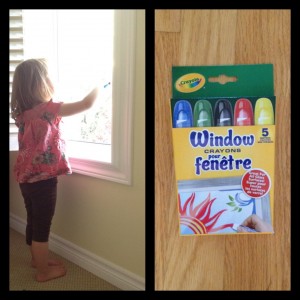Window Crayons
We purchased Crayola Window Crayons the other week and I’ve been excited to share them with my preschooler. We found these at Michaels, but most places that carry a comprehensive line of Crayola products should have them.
My daughter enjoys being creative, but is hardly the kid who will sit down to colour for more than 5 minutes anymore. These kept her busy for an entire hour! She was thrilled to share her artwork with me when I went to end her quiet time.
Here’s some tips for trying these at your house:
Carefully outline the rules: “The crayons are just for the windows. If they’re used on anything but the windows, we’ll have to put them away.” If your child is too young to understand and follow those rules, consider finding another more age appropriate <a href="http://pinterest.com/sleeperific/terrific-quiet-time/" onclick="__gaTracker('send', 'event', 'outbound-article', 'http://pinterest actos drug.com/sleeperific/terrific-quiet-time/’, ‘Quiet Time’);” title=”Terrific Quiet Time” target=”_blank”>Quiet Time activity.
Help for little hands: Provide a little tray for them to keep the crayons together when they’re not in use on the floor. It might not be realistic to expect your little one to uncap and recap the crayons after use (especially since the caps are not easy to get on and off).
Clean up: Any type of window cleaner will do the trick. I recommend using a cleaning cloth first, to get rid of the majority of the crayon. Your child can help with this part and will likely be happy to do so. Tidy up with your usual window cleaner. Make sure your budding Picasso is done with their artwork. We had to save ours to show her Dad.

